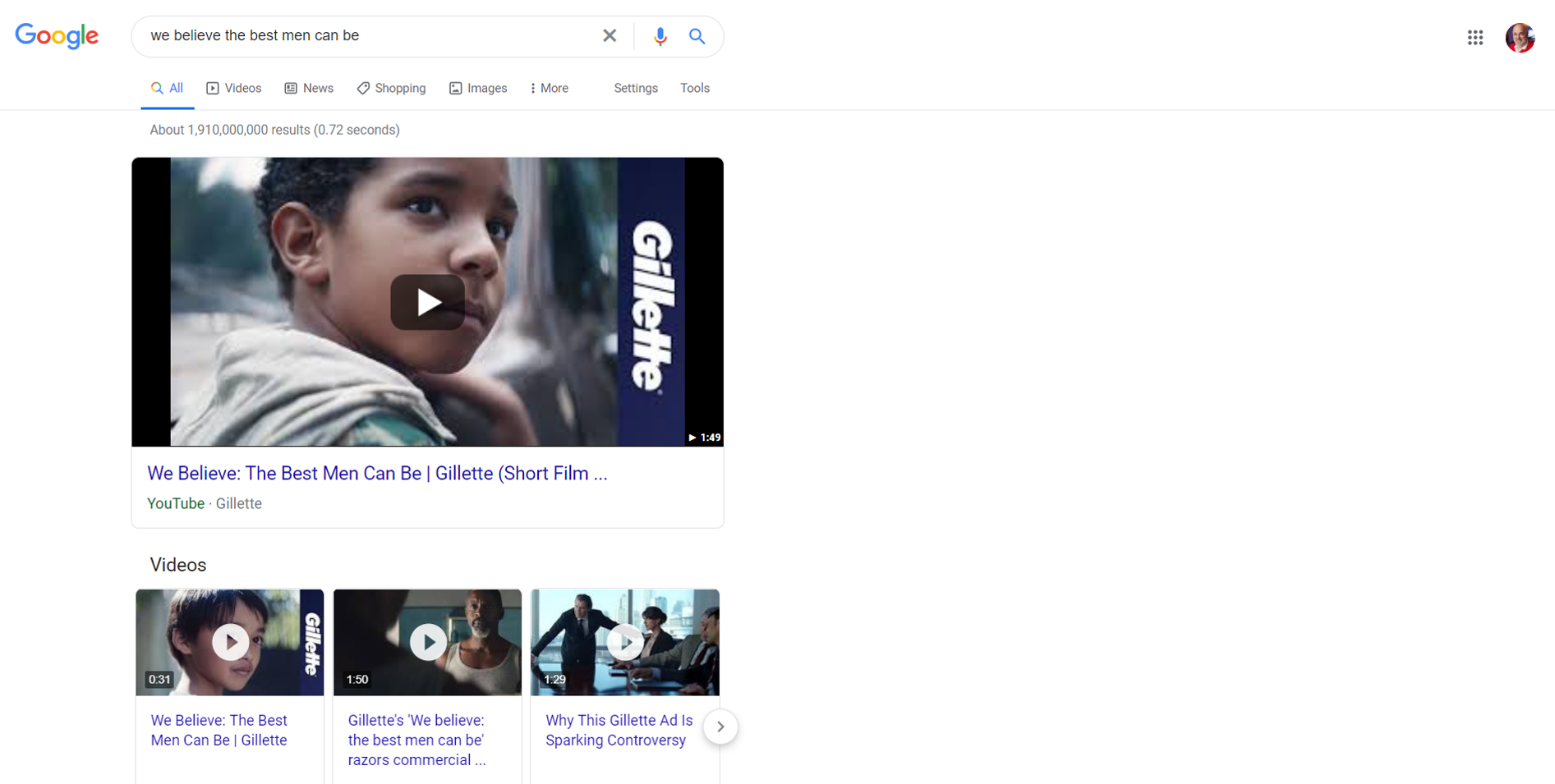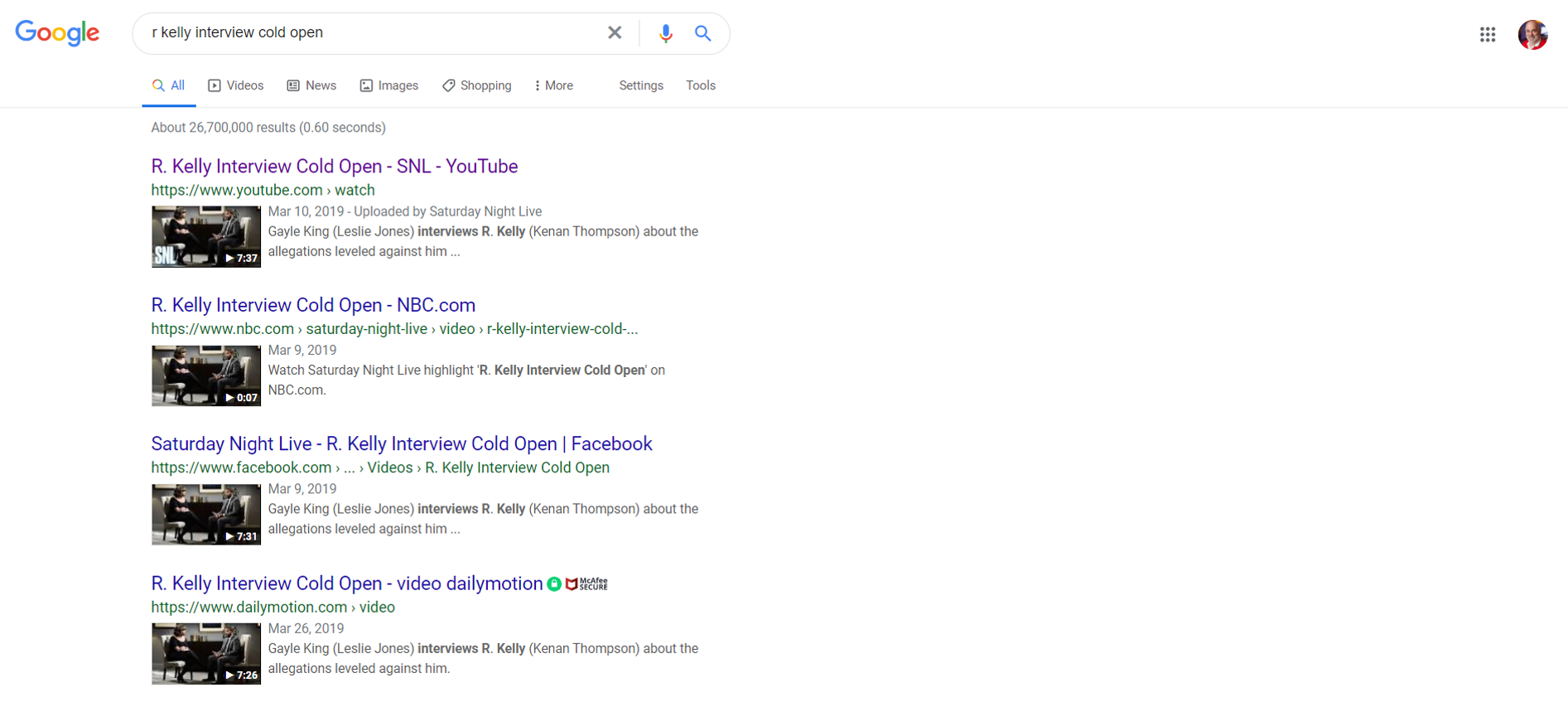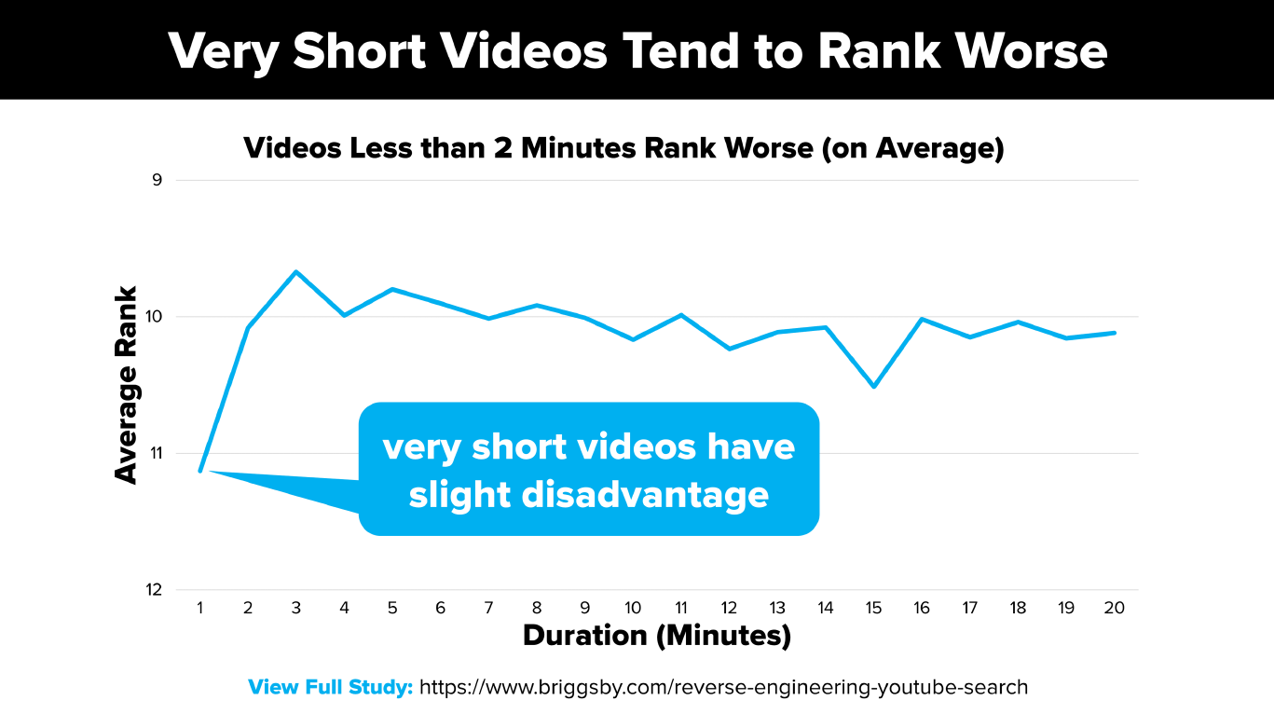When Searchmetrics presented Slide #14 in their “2019 SEO Year-End Review” presentation, you could have knocked me over with a feather.
That’s when I discovered that YouTube has steadily (and stealthily) increased its organic visibility in Google’s SERPs over the past two years and recently surpassed Wikipedia for the #1 spot.

Stop the presses! That’s significant information.
So, why did Searchmetrics bury their lead?
Because they told the story of how the SEO industry changed during 2019 in chronological order. In fact, YouTube reaching #1 was the fourth topic covered in the on-demand version of their webcast.
Now, I realize that Google’s core updates on March 12, June 3, and September 24 deserved to be covered in a 2019 SEO year-end review. And so did Google’s BERT update on October 24.
But, none of these stories are “new” news to SEOs. Ironically, this meant that the most newsworthy information followed a third section on “industry trends.”
But, from a journalist’s perspective, YouTube edging past Wikipedia in organic visibility in Google SERPs is the most important “news you can use” in 2020.
How to Optimize Your Videos for YouTube & Google
Now, to use this news, you’ll need to optimize your videos for YouTube as well as for Google. I’ll tell you how to do that, but it isn’t that simple.
First, you need to optimize your videos for YouTube’s algorithm.
And, as I mentioned last year in my post, “Why You Must Unlearn What You Know About the YouTube Algorithm,” it’s hard to boil that down when YouTube’s algorithm works one way when videos are brand new and another way when they are more than six weeks old.
As a quick recap, optimizing your metadata (the titles, tags, and descriptions for your content) matters less once YouTube has more data on watch time (the amount of time in aggregate that your viewers are watching your videos).
Second, you also need to optimize your videos for Google’s universal search algorithm. And, as SEOs know all too well, Google made 3,234 “improvements” to search in 2018 – an average of almost 9 per day.
Although most of these changes were minor, Google occasionally rolls out major algorithmic updates (like the three core updates in 2019) that affect search results in more significant ways.
But, there is some high-level guidance that I can share with the SEO community.
1. Create Great YouTube Content for Both the YouTube & Google Audiences
The key to success is to create great YouTube content for both YouTube and Google audiences.
And, the biggest difference between them isn’t demographic or geographic. It’s psychographic.
Your YouTube audience is twice as likely to be early adopters, agreeing that “I am among the first of my friends and colleagues to try new products.”
And your YouTube audience is 1.8x more likely to be influencers, agreeing that “people often come to me for advice before making a purchase.”
Now, you generally need your primary audience to discover, watch, like, share, and add comments to your video content on YouTube before your secondary audience will see it in a Google SERP.
The exceptions to this process are compelling commercials or funny skits on TV that people hear about from their friends, family, or colleagues and then go searching for on Google as well as YouTube.
For example, if you analyze YouTube’s list of Top Trending Videos of 2019 (USA), then you’ll quickly see that all but two were uploaded by popular YouTube Creators (aka early adopters and influencers). But, let’s take a closer look at the two exceptions, which also appeared on TV.
One is “We Believe: The Best Men Can Be | Gillette (Short Film).” As the video’s description says:
“Bullying. Harassment. Is this the best a man can get? It’s only by challenging ourselves to do more, that we can get closer to our best. To say the right thing, to act the right way. We are taking action at https://gillette.com/en-us/about/the-best-men-can-be Join us.”
Uploaded on January 13, 2019, the video is 1:48 long, and has more than 33 million views and 807,000 “Likes,” making it the fifth most liked video of the year. And, as you can see below, it ranks #1 in Google.

The other is “R. Kelly Interview Cold Open – SNL.” As the video’s description says:
“Gayle King (Leslie Jones) interviews R. Kelly (Kenan Thompson) about the allegations leveled against him.”
Uploaded on March 10, 2019, this 7:36 video has almost 15.9 million views and 233,000 “Likes,” making it the ninth most liked videos of the year.
And as you can see below, the YouTube version ranks #1, the version on NBC.com ranks #2, the Facebook version ranks #3, and the Dailymotion version ranks #4 in the Google SERP.

In other words, you need to create great YouTube content or great TV content that is also uploaded to YouTube if you want it to appear in Google’s SERPs.
And, although many brands and media companies create TV content, they seem to be afraid or unable to create the kind of great content that popular YouTube Creators, Gillette, and SNL created in 2019.
There are other steps that you should take to optimize your videos for YouTube and Google.
2. Create Descriptive & Accurate Metadata & Thumbnails
Now, I don’t need to tell SEOs that YouTube is the world’s second-largest search engine, behind only Google. But, did you know they have different algorithms?
The goals of YouTube’s search and discovery algorithm are:
“To help viewers find the videos they want to watch, and to maximize long-term viewer engagement and satisfaction.”
So, before or after you’ve created great YouTube content that maximizes viewer engagement and satisfaction, you should:
Conduct Keyword Research
Conduct keyword research to find what your target audiences want to watch on YouTube or discover on Google. I recommend using one or both of the following tools:
This tool has both Google and YouTube search data going back more than 12 years.
This enables you to see if there is existing YouTube search interest as well as Google search interest in the keywords, terms, and phrases that you plan to use to write optimized titles, tags, and descriptions for your video content.
And don’t be surprised to discover that search interest trends on YouTube are different than they are on Google.
Keyword Tool & Its Sister Keyword Tool for YouTube
Both use the autocomplete features on Google as well as YouTube to generate highly relevant long-tail keywords.
While there are lots of other keyword tools for Google, you want to identify terms and phrases that will help your videos get found on both YouTube and Google. So, that narrows your list of tool options fairly dramatically.
Use Compelling Titles for Your Videos That Accurately Represent the Content
How do you make a video’s title compelling?
Well, ask yourself, “If it showed up in a search, would my target viewer click on it?”
Now, basic YouTube SEO advice recommends that you should include relevant keywords in your title. The study by Justin Briggs that I wrote about last year found that this advice was still valid. But, an analysis of text-based targeting came to a more nuanced conclusion.
The study, which looked at 3.8 million data points across 100,000 videos and 75,000 channels, found that:
- 90% of high ranking videos had some had some variant of the keyword in the title. So, exact match keywords help, but they aren’t required.
- There is a relationship between title length and ranking performance. Most titles on videos ranking in the top 20 positions averaged around 47-48 characters, with the highest-ranking YouTube videos having titles 20-40 characters long.
Write Detailed Descriptions Using Video SEO Best Practices
The same study by Briggs found that there is a positive relationship between broad match keyword usage in descriptions and ranking.
However, with only 75% of top 20 results using some broad match variant in their description text, it was not as essential as including your keyword in your title. But, it is still highly recommended.
Briggs also found that a lengthy and more robust description was advantageous, but only to a point. The sweet spot seemed to be between 200 and 350 words.
Beyond 350 words, average rank performed worse on average. Now, only the first few sentences of your description will appear in search results or above the fold on a watch page – so make them count!
Use a Comprehensive Number of Related Video Tags
Although Google does not use the keywords meta tag in web ranking, YouTube uses tags to help viewers find the videos they want to watch.
And, the YouTube Search and Discovery team says that the influence of tags is variable based on different factors, such as how closely the tags are related to each other on a topic.
In the past, YouTube has recommended using the whole 270-character limit. And Briggs found the sweet spot was around 200 to 300 characters.
So, it seems that the more data you give YouTube in the keyword tag field, the better a video performs in YouTube search and suggested videos.
YouTube also seemed to prefer 2-4 word phrases over many single word phrases when Briggs compared this to the optimal number of unique tags used to achieve the character count.
Tag performance was highest between 31 and 40 distinct tags, which may suggest it’s better to target multiple moderate-length keywords than it is to use very short or very long keyword phrases.
Create Thumbnails That Accurately Represent Your Content
Although it doesn’t impact ranking, you should also create thumbnails that accurately represent your content.
Thumbnails show up in different sizes and formats all across YouTube and outside of it on Google.
You need to make sure you’ve got a strong, vibrant image that pops no matter what size it is. This can encourage a viewer to click on your video even if it’s ranked below another one.
3. Keep Viewers Watching with Video Best Practices
Once viewers have discovered your video, you need to keep them watching it – if you are going to rack up enough watch time to rank well on YouTube as well as appear in Google.
This means you need to be an effective editor.
Create a compelling opening to your videos to hook viewers right from the start, as well as maintain and build interest throughout the video.
To do this, you need to master the storytelling techniques that I wrote about in my October 2018 post entitled, “6 Lessons In Video Storytelling You Can Learn from Indian Brands.”
So, how long a story should you tell?
Before October 2012, I would have said about 2 to 3 minutes long.
But, based on the importance of watch time in YouTube’s ranking algorithm, I now recommend that you create great content that is longer than 4:30, but shorter than 16:00.
In fact, the study by Briggs found that “duration,” or how long a YouTube video is, had several surprising impacts on ranking and viewer behavior. He said:
“A lot of creators struggle with how long they should make a video, and this data helps answer that.”
Briggs found viewers tended to like longer, but not too long, videos.
For example, the videos that were most effective at converting views into likes were those between 10 and 16 minutes long.
Videos less than 5 minutes long tended to get a lower percentage of positive reviews, and videos longer than 16 minutes started to see a decline in engagement.
His study also found that short videos were typically rated very poorly.
In general, videos less than a minute did very, very poorly concerning positive reviews. Positive sentiment improved with every minute up until about 4 minutes, where it evened out.
But, how does duration influence rankings?
Briggs found that YouTube’s algorithm seemed to follow the audience. The algorithm appeared to rank videos less than 2 minutes notably worse, but this evened out after about 4 minutes.
He also found that a video’s duration helps a lot to drive incremental watch time up until about 4.5 minutes, but it only helps a little after 4.5 minutes.
However, it didn’t decline. It continues to rise, so if you’re trying to maximize watch time, do not shy away from 10+ minute videos. Also, there is no decline in sentiment, rank, or views for videos beyond 10 minutes.
This point is vital, because watch time is a significant ranking factor.
While there is a retention curve associated with video duration which describes how users typically “fall off” throughout a video, longer videos can drive incremental watch time, even if they become less efficient at doing this with each additional minute.
In simple terms, a 5-minute video might get more views than a 10-minute video, but the 10-minute video is more likely to accumulate a substantial amount of watch time to make up for that.
In the study by Briggs, 10-minute videos had about 15% more watch time than those that were 5 minutes. And Briggs saw 10+ minute videos ranking well in YouTube search.
In fact, the average duration of videos that ranked in the top 5 positions was 11 minutes and 44 seconds, and there appeared to be a positive relationship between video length and ranking.

Now, you can’t fix the duration of your existing videos retroactively. So, you’ll need to start creating a higher percentage of longer videos going forward.
You should also build your subscriber base. Subscribers are your most loyal fans and will be notified of new videos and playlists to watch.
In addition, the study by Briggs found that larger channels with higher subscriber counts also had higher rankings than those with fewer subscribers in their niche.
He said:
“There is a positive relationship between subscriber counts and rankings. While this might be a ‘channel authority’ style signal, it’s important to think of subscriptions as a CRM / distribution list. Channels with larger subscriber counts have a useful tool that drives views through browse features, personalized recommendations, and notifications.”
Briggs added:
“It’s also suggestive of an inherent, engaged audience that can seed videos with a baseline level of views from viewers that are prone to have better retention and longer session durations, driving up watch time relative to channels with less brand affinity. It may also be suggestive of a higher likelihood of binge-watching and playlist usage, which can help seed videos with better co-watch data to power video recommendations.”
You should also engage your audience. Online video is an inherently social medium.
Involve your audience in your videos, encourage comments, and interact with your viewers as part of the content. In addition, leverage other social media, especially Facebook, Twitter, and LinkedIn.
4. Organize & Program Your Content
Build Long Watch-Time Sessions by Organizing Themed Content Using Playlists
ou can use your own videos, other videos, or a combination of both. This not only creates another asset that can appear in YouTube search results and in Suggested Videos, it also increases the watch time of videos on your channel and across YouTube.
Create a Regular Release Schedule and Publish Videos More Frequently
Releasing content frequently on a recurring schedule keeps your audience’s interest and impacts YouTube’s algorithm. This means you need to develop a programming strategy.
If You Can’t Beat Them, Join Them
Although it’s relatively new “news” that YouTube.com has steadily (and stealthily) increased its organic visibility in Google’s SERPs over the past two years and recently surpassed Wikipedia.org for the #1 spot, most of the best practices for video SEO were published almost a year ago.
So, why haven’t more SEOs taken advantage of this significant trend?
Well, I suspect there are several possible explanations.
For starters, YouTube videos started appearing in Google universal search results back in May 2007, but only 500,000 out of the 3 million SEOs in the world mention “video SEO” in their LinkedIn profile today. So, five out of six SEOs around the globe still don’t think video SEO is part of their job.
In addition, many organizations put SEO and YouTube marketing in different silos in the org chart and even different locations around the country. So, there is little informal collaboration between the two.
Finally, as I mention above, many brands and media companies seem to be afraid or unable to create the kind of great content that popular YouTube Creators, Gillette, and SNL created in 2019.
So, let me conclude by giving you another option: Sponsored videos.
According to Tubular Labs data, 180,000 brands have sponsored 1.3 million videos in 400,000 campaigns created by 115,000 content partners.
In other words, if your organization or client can’t or won’t create the kind of great content that popular YouTube Creators do, then sponsor their next video.
For example, Sam’s Club sponsored a video entitled, “Real Life Trick Shots 3 | Dude Perfect.” Uploaded February 25, 2019, this video is 3:42 long, and it has 69.5 million views and 1.5 million “Likes.”
And, as you can see below, it ranks #1 on Google.

In other words, if you can’t beat them, join them.
More Resources:
- Why You Must Unlearn What You Know About the YouTube Algorithm
- 6 of the Best YouTube & Video Optimization Tools to Boost Your Views
- 4 Reasons Why Your Videos Aren’t as Successful as Your Blog Posts
Image Credits
In-Post Image: Searchmetrics
All screenshots taken by author, December 2019


